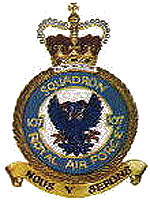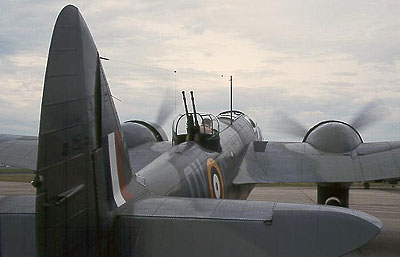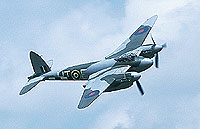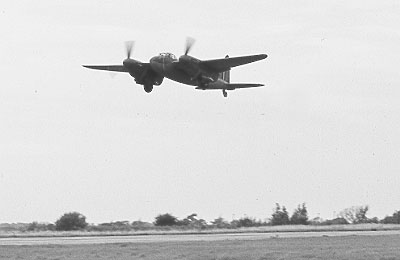![]()
107
Squadron: The beginning by
Gary Parsons
 The first squadron
to be formed at Wattisham, 107 Squadron is one of those with a distinguished
war record but faded away in the cutbacks of the post war years.
The first squadron
to be formed at Wattisham, 107 Squadron is one of those with a distinguished
war record but faded away in the cutbacks of the post war years.
Formed at Catterick, Yorkshire on 8 October 1917 from Nr 46 TS, the squadron went to France during June 1918 and saw extensive action on the Western Front with its DH9s, returning to the UK from Maubeuge and disbanding on 13 August 1919 at Hounslow.
Reformation came in August 1936 at Andover with Hawker Hinds, the squadron moving to Old Sarum in Wiltshire. Hinds were the mainstay of the medium bomber fleet in the mid-thirties, 107 Squadron moving with their particular mounts to Harwell in Oxfordshire in June 1937. It was not until August 1938 that more modern machines would find their way to 107 when Blenheim Is arrived, just before the Munich crisis.
 Arriving at the new station of Wattisham in April 1939,
107's early war escapades with the Blenheim included the first attack
at Wilhelmshaven, under the control of Flt Lt Kenneth Doran who was awarded
the DFC for the squadron's efforts, the first decoration awarded of the
war. Throughout the remainder of '39 and into 1940 the unit, together
with 110 Squadron, made many attacks by day and night on a variety of
targets, including U-Boats. Led by Wing Commander Basil Embry, one U-Boat
was sunk before he was downed in action on 27 May, his story of evading
the Germans and reaching Gibraltar recounted in his biography Mission
Completed. During these early war years detachments were sent to far-flung
places such as Lossiemouth, Leuchars, Manston, Malta and, er...Ipswich,
all the while completing dangerous anti-shipping missions, often incurring
heavy losses.
Arriving at the new station of Wattisham in April 1939,
107's early war escapades with the Blenheim included the first attack
at Wilhelmshaven, under the control of Flt Lt Kenneth Doran who was awarded
the DFC for the squadron's efforts, the first decoration awarded of the
war. Throughout the remainder of '39 and into 1940 the unit, together
with 110 Squadron, made many attacks by day and night on a variety of
targets, including U-Boats. Led by Wing Commander Basil Embry, one U-Boat
was sunk before he was downed in action on 27 May, his story of evading
the Germans and reaching Gibraltar recounted in his biography Mission
Completed. During these early war years detachments were sent to far-flung
places such as Lossiemouth, Leuchars, Manston, Malta and, er...Ipswich,
all the while completing dangerous anti-shipping missions, often incurring
heavy losses.
A move north to Great Massingham in Norfolk followed on 11 May 1941, ending the short but effective association with 110 Squadron. Re-equipment with foreign machinery came in early 1942, the Boston III replacing the now long-in-the-tooth Bristol Blenheim. A first mission with the new aircraft occurred on 8 March when six Bostons, led by Sqn Ldr Lynn made a medium-level raid on Abbeville's railway marshalling yards. Later duties included escorted daytime bombing raids and training for gas-spray operations, although the latter is believed not to have been put into practise. A brief move to Ford in Hampshire to cover the Dieppe landings happened in August, followed by detachments to Charlton Horethorne in Somerset and Annan in Scotland, but normal operations from Massingham soon resumed.
1943 saw 107 continuing a variety of missions using the Boston; steel works, power stations, naval stores all receiving the worst that the squadron could throw at them, the aircraft flying ever lower in their task. The Boston was ideally suited to this method of attack, not as accomplished as the Mosquito but the twin-engined medium bomber proved almost as capable.
 It was
time to leave Massingham however, as a move to Blackbushe in Hampshire
provided the squadron with an increase in range over enemy territory.
NR 2 Group Wing was formed with 107 joining the Bostons of 88 Squadron
and the Venturas of 21 Squadron, the main purpose for which was Operation
Starkey. This was the concentrated bombing of marshalling yards, ammunition
dumps, airfields and power stations in occupied territory. In November
V1 sites were targeted, the start of the menace of the Doodlebug against
mainland Britain. These became the Bostons primary target through the
winter, a move to Lasham in February 1944 moving the squadron closer to
London and bringing with it the Mosquito, perhaps the finest aircraft
of the war. At this time, an unfortunate case of Friendly Fire occurred
when one of 107's Mossies was downed by a USAAF P-51. The Mosquito pilot,
also an American, survived unscathed but managed to trace his assailant
and promptly paid him a visit, suffice to say not to thank him!
It was
time to leave Massingham however, as a move to Blackbushe in Hampshire
provided the squadron with an increase in range over enemy territory.
NR 2 Group Wing was formed with 107 joining the Bostons of 88 Squadron
and the Venturas of 21 Squadron, the main purpose for which was Operation
Starkey. This was the concentrated bombing of marshalling yards, ammunition
dumps, airfields and power stations in occupied territory. In November
V1 sites were targeted, the start of the menace of the Doodlebug against
mainland Britain. These became the Bostons primary target through the
winter, a move to Lasham in February 1944 moving the squadron closer to
London and bringing with it the Mosquito, perhaps the finest aircraft
of the war. At this time, an unfortunate case of Friendly Fire occurred
when one of 107's Mossies was downed by a USAAF P-51. The Mosquito pilot,
also an American, survived unscathed but managed to trace his assailant
and promptly paid him a visit, suffice to say not to thank him!
 Cover for the D-Day
landings was the priority for the summer of '44, followed by precision
attacks on the retreating enemy. Again led by Basil Embry, by now an Air
Vice Marshal, attacks were made against strongholds and chateaus where
SS troops were known to stay. Arnhem followed in September with low-level
attacks on particular houses in the town, 107 losing two aircraft on this
particular mission.
Cover for the D-Day
landings was the priority for the summer of '44, followed by precision
attacks on the retreating enemy. Again led by Basil Embry, by now an Air
Vice Marshal, attacks were made against strongholds and chateaus where
SS troops were known to stay. Arnhem followed in September with low-level
attacks on particular houses in the town, 107 losing two aircraft on this
particular mission.
Returning from Lasham in October 1944 to Blackbushe, 107's Mosquitos prepared for deployment to Europe to support the advancing allied army through France and Belgium. Poor weather delayed any move until 19 November when the unit flew into Cambrai and hence on through to Germany, supporting the troops until the end of the war. Addressing the victory parade in Brussels on 8 May 1945 was no less than Air Vice Marshal Basil Embry CBE DSO DFC. It was to be three years before disbandment, along with so many other courageous squadrons of the second world war. After various postings to West German bases such as Sylt and Gutersloh the end came on 15 September 1948 when the squadron was renumbered as 11 Squadron.
107 briefly re-appeared in the sixties, when in July 1959 it re-formed at Tuddenham in Suffolk as a Thor ICBM squadron as part of the British nuclear deterrent. Twenty squadrons were established at several locations, mainly in the Lincolnshire/Huntingdon area, using the squadron numbers of disbanded wartime bomber units. Only three missiles were ever assigned, and with all Thor units its life was brief, as in 1963 the system was dismantled and once again 107's standard laid to rest.